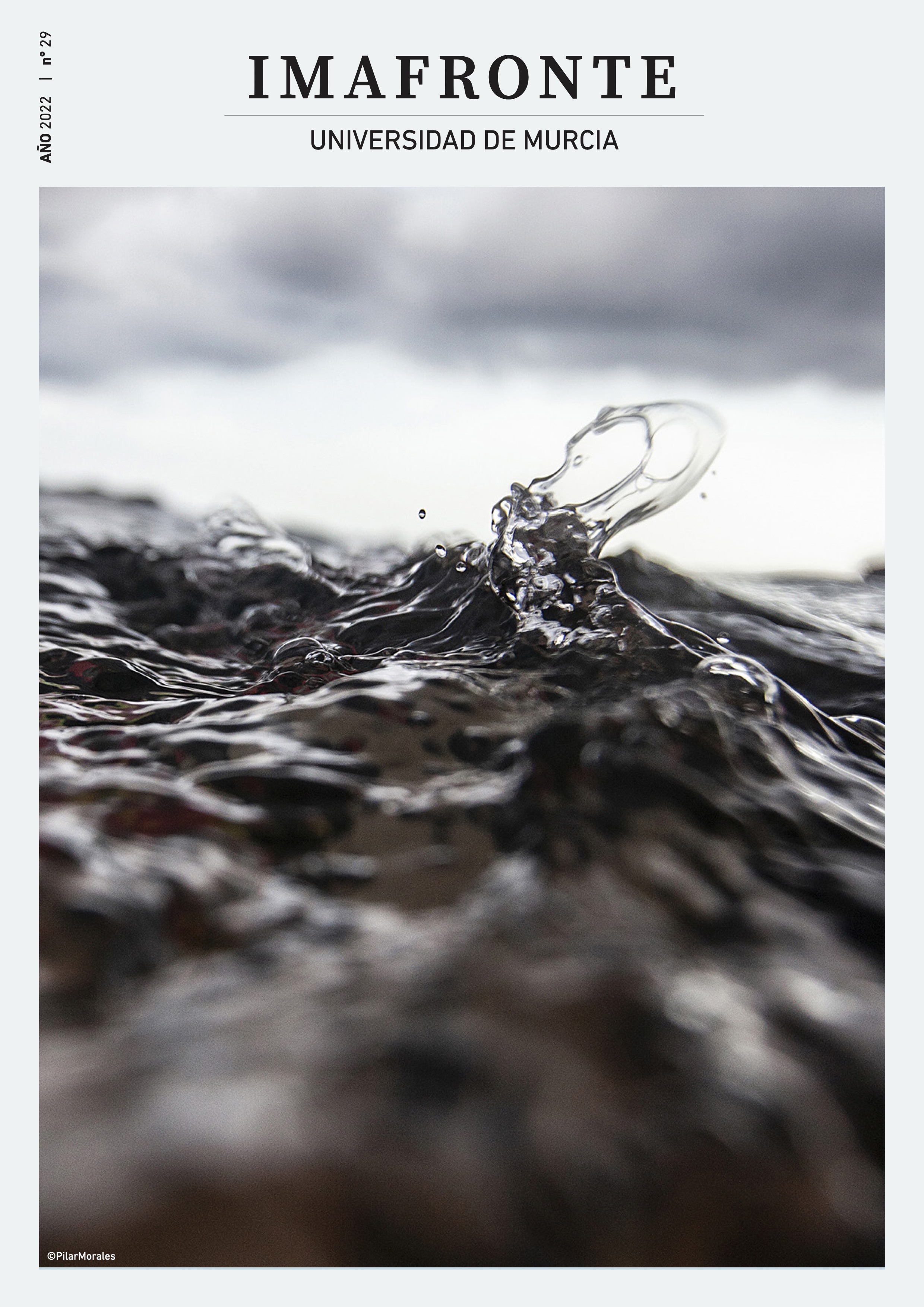«Become nothing» (Nichtesnit Werden):
The Grave-camera and the night light in the Turin Horse (2011, Béla Tarr)
Abstract
The documentary film Béla Tarr, I Used to Be a Filmmaker (2013, directed by Jean-Marc Lamoure) shows how the great Hungarian filmmaker Béla Tarr (b. 1955) uses the camera at ground level (as Yasujirō Ozu), and even sunk in a hole made on purpose to shoot the sequence of the hill of A torinói ló (The Turin Horse, 2011), his later film. The purpose of this article is to highlight this fact as a form of symbolic death, the camera-tomb, an ascetic exercise of the «bond with the grave», since the whole film is a «reproducing life», in the words of the filmmaker himself, from the end, typified by the omnipresent wind of the Absolute (the whistle of Silent), the desert of desolation and the black screen (vision from the ‘grave’, «the deep silence» of the voice-over), with which open and close the film.
Downloads
-
Abstract1213
-
PDF (Español (España))689
-
EPUB (Español (España))117
References
Angela da Foligno (1992). Il libro dell’esperienza. Milán: Adelphi.
Baldwin, H. L. (1990). Samuel Beckett’s Real Silence. University Park: Penn State University Press.
Bara Bancel, S. (2015). Teología mística alemana. Estudio comparativo del «Libro de la Verdad» de Enrique Suso y la obra del Maestro Eckhart. Münster: Aschendorff.
Bataille, G. (1973). La experiencia interior. Madrid: Taurus.
Bataille, G. (2001). Lo Imposible. Historia de ratas seguido de Dianus y de la Orestiada. Madrid: Arena Libros.
Bataille, G. (2018). Teoría de la religión & El culpable. Madrid: Taurus.
Baudelaire, Ch. (2003). Obra poética completa. Madrid: Akal.
Bazin, A. (1960). ¿Qué es el cine? Madrid: Rialp.
Bazin, A. (1977). El cine de la crueldad. Eric Von Stroheim, Preston Sturges, Alfred Hitchcock, Carl Th. Dreyer, Luis Buñuel, Akira Kurosawa. Bilbao: Mensajero.
Beckett, S. (1969). Molloy. Barcelona: Lumen.
Beckett, S. (2000). Obra poética completa. Madrid: Hiperión.
Blanchot, M. (1969). El espacio literario. Barcelona: Paidós.
Blanchot, M. (1977). Falsos pasos. Valencia : Pre-Textos.
Blanchot, M. (1982). Thomas el oscuro. Nueva versión. Valencia: Pre-Textos.
Blanchot, M. (1999). La bestia de Lascaux; El último en hablar. Madrid: Tecnos.
Blanchot, M. (2008). La conversación infinita. Madrid: Arena Libros.
Blanchot, M. (2015). La escritura del desastre. Madrid: Trotta.
Borges, J. L. (1971). El Aleph. Madrid: Alianza.
Bréhier, É. (1919). L’idée du néant et le problème de l’origine radicale dans le néoplatonisme grec. Revue de Métaphysique et de Morale, 26(4), 443-475.
Caputo, J. D.; Vattimo, G. (2010). Después de la muerte de Dios. Conversaciones sobre religión, política y cultura. Barcelona: Paidós.
Charles-Saget, A. (1994), Non-être et Néant chez Maître Eckhart. En Zum Brunn, É. (Comp.). Voici Maître Eckhart. Grenoble: Jérôme Million, 301-318.
Cuesta Abad, J. M. (2003). El poeta de la nada moderna. En Baudelaire, Ch. Obra poética completa. Madrid: Akal.
Dan, J. (1987). Paradox of Nothingness in the Kabbalah. En Colin, A. D. (Ed.). Argumentum e Silentio. International Paul Celan Symposium / Internationales Paul Celan-Symposium. Berlín; Nueva York: Walter de Gruyter, 359-363.
Derrida, J. (1989). La escritura y la diferencia. Barcelona: Anthropos.
Eckhart, M. (1998). El fruto de la nada y otros escritos. Madrid. Siruela.
Eliot, T. S. (2016). Cuatro cuartetos, La roca y Asesinato en la catedral. Barcelona: Lumen.
Grosoli, M. (2015). Armonie contro il giorno. Il cinema di Béla Tarr. Interviste in appendice a cura di Michael Guarneri. Bolonia: Bébert.
Haas, A. M. (1989). Gottleiden-Gottlieben. Zur volkssprachlichen Mystik im Mittelalter. Fráncfort d. M.: Insel.
Haas, A. M. (2002). Maestro Eckhart. Figura normativa para la vida espiritual. Barcelona: Herder.
Haas, A. M. (2009). Viento de lo absoluto. ¿Existe una sabiduría mística de la posmodernidad? Madrid: Siruela.
Hadewijch d’Anvers. (1954). Écrits mystiques des Béguines. Poèmes spirituels. París: Seuil.
Hadewijch de Amberes. (1980). Hadewijch: The Complete Works. Nueva York: Paulist Press.
Heidegger, M. (1983). Interpretaciones sobre la poesía de Hölderlin. Barcelona: Ariel.
Idel, M. (2010). Old Worlds, New Mirrors. Jewish Mysticism and Twentieth-Century Thought.
Filadelfia: University of Pennsylvania Press.
Jabès, E. (2000). Del desierto al libro. Entrevistas con Marcel Cohen. Madrid: Trotta.
Jasper, D. (2004). The Sacred Desert. Religion, Literature, Art, and Culture. Malden; Oxford: Blackwell.
Kovács, A. B. (2013). The Cinema of Béla Tarr. The Circle Closes. Londres; Nueva York: Wallflower Press (Columbia University Press).
Kovacsics, V. (2012). The Turin Horse. Libreto de The Turin Horse. DVD. Versus Entertainment.
Kuhn, E. (1992). Friedrich Nietzsches Philosophie des Europäischen Nihilismus. Berlín; Boston: De Gruyter.
Laruelle, F. (1988). Du noir univers: dans les fondations humaines de la couleur. La Décision philosophique, 5, 107-112.
Lévinas, E. (2000). Sobre Maurice Blanchot. Madrid: Trotta.
Libera, A. de. (2000). Pensar en la Edad Media. Barcelona: Anthropos.
Mallarmé, S. (1981). Obra poética II. Madrid: Hiperión.
Mallarmé, S. (2005). Para una tumba de Anatole. Vitoria-Gasteiz: Bassarai.
Mancho Duque, Ma. J. (1982). El símbolo de la noche en San Juan de la Cruz. Estudio léxico-semántico. Salamanca: Ediciones Universidad de Salamanca.
Mandelstam, O. (2010). Poesía. Madrid; México: Vaso Roto.
Manrique, M. (Coord.) (2016). Béla Tarr: ¿qué hiciste mientras esperabas? Santander: Shangrila.
Matt, D. C. (1990). Ayin: The Concept of Nothingness in Jewish Mysticism. En Forman, R. K. C. (ed.). The Problem of Pure Consciousness. Mysticism and Philosophy. Nueva York; Oxford: Oxford University Press, 121-159.
Maury, C.; Rollet, S. (Dir.). (2016). Béla Tarr. De la colère au tourment. Crisnée: Yellow Now.
McGinn, B. (1994), Ocean and Desert as Symbols of Mystical Absorption in the Christian Tradition. The Journal of Religion, 7, 155-181.
Nietzsche, F. W. (1988). Sämtliche Werke. Kritische Studienausgabe in 15 Einzelbänden, Deutscher Taschenbach. Múnich; Berlín: Walter de Gruyter.
Petković, V. (2011). Béla Tarr, Director. Simple y puro. En ˂https://cineuropa.org/es/interview/198131/˃ (fecha de consulta: 06-12-2020).
Pfeiffer, F. (Ed.) (1991-). Meister Eckhart. Aalen: Scientia.
Porete, M. (2005). El espejo de las almas simples. Madrid: Siruela.
Quignard, P. (1998). El odio a la música. Diez pequeños tratados. Barcelona: Andrés Bello.
Quignard, P. (2004). Vida secreta. Madrid: Espasa Calpe.
Rancière, J. (2013). Béla Tarr, el tiempo del después. Santander: Shangrila.
Rovatti, P. A. (1990). Como la luz tenue. Metáfora y saber. Barcelona: Gedisa.
Sachs, N. (2009). Viaje a la transparencia. Obra poética completa. Madrid: Trotta.
Schefer, J. L. (1980). L’homme ordinaire du cinéma. París: Gallimard.
Scholem, G. (2001). Los orígenes de la Cábala. 2 vols. Barcelona: Paidós.
Seuse, H. (2013). Vida. Madrid: Siruela.
Severino, E. (1991). Esencia del nihilismo. Madrid: Taurus.
Tarkovski, A. (1991). Esculpir en el tiempo. Reflexiones sobre el arte, la estética y la poética del cine. Madrid: Rialp.
Trebolle, J. (Trad.) (2001). Libro de los salmos. Himnos y lamentaciones. Madrid: Trotta.
Ueda, S. (2004). Zen y filosofía. Barcelona: Herder.
Valente, J. Á. (2008). Obras completas II. Ensayos. Barcelona: Galaxia Gutenberg; Círculo de Lectores.
Wackernagel, W. (1991). Ymagine denudari. Éthique de l’image et métaphysique de l’abstraction chez Maître Eckhart. París: J. Vrin.
Weil, S. (1994). La gravedad y la gracia. Madrid: Trotta.
Zajonc, A. (2015). Capturar la luz. La historia entrelazada de la luz y la mente. Girona: Atalanta.
Zambrano, M. (2011-). Obras completas. 8 vols. en 9 t. Barcelona: Galaxia Gutenberg.
(El) Zohar (1977-78). 5 vols. Buenos Aires: Sigal.
Copyright (c) 2022 Antoni Gonzalo Carbó

This work is licensed under a Creative Commons Attribution-ShareAlike 4.0 International License.
1. The authors non-exclusively assign the exploitation rights (reproduction, distribution, communication and transformation) to the magazine.
2. The works published in this magazine are subject to the Attribution-ShareAlike 4.0 International license (CC By SA 4.0). Therefore, they can be copied, used, disseminated, transmitted and publicly displayed, provided that:
i) the authorship and the original source of its publication (journal, editorial and URL of the work) are cited, thus allowing its recognition.
ii) it is allowed to remix, transform or create from the material while maintaining the same license as the original.

3. Self-archiving conditions. Authors are allowed and encouraged to electronically disseminate the pre-print (version before being evaluated) and/or post-print (version evaluated and accepted for publication) versions of their works before publication, as it favors their publication. Earlier circulation and diffusion and with it a possible increase in its citation and reach among the academic community. Color RoMEO: verde.






















